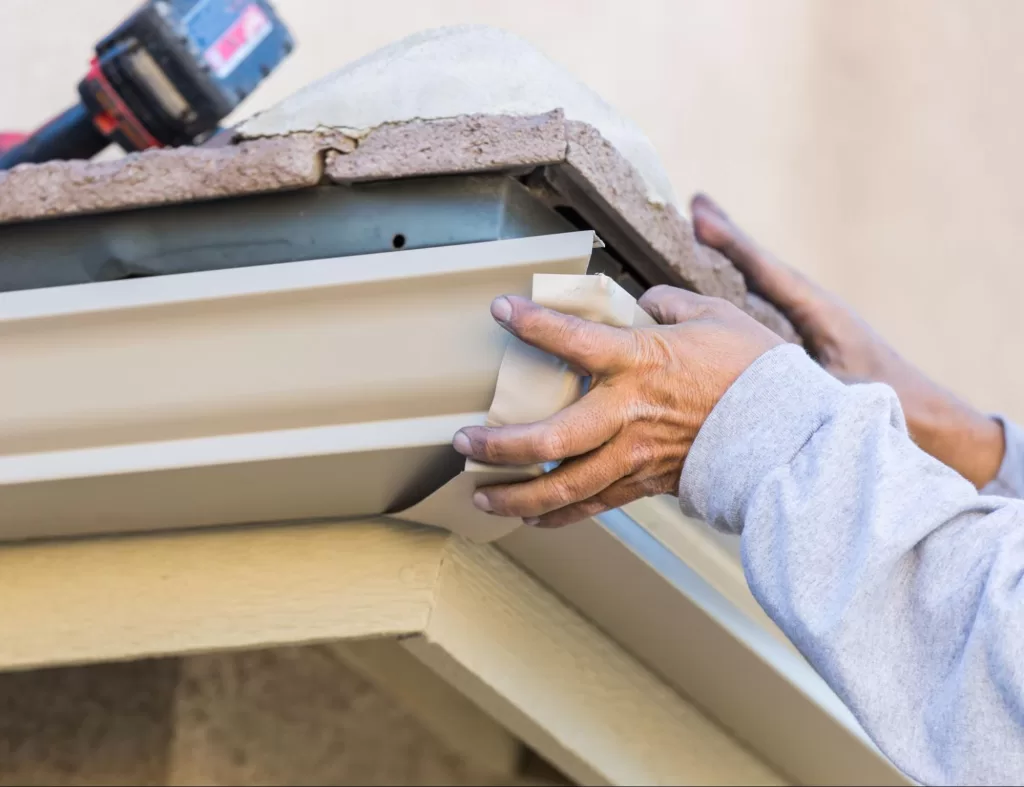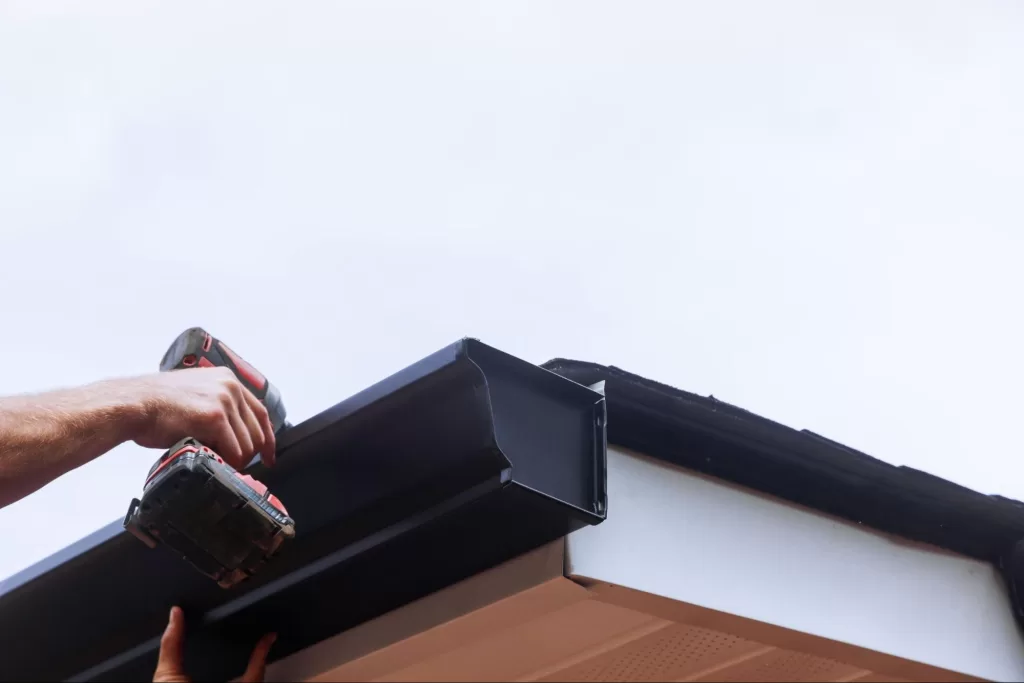
Most homeowners don’t think about their gutters until something goes wrong. But when it comes to protecting your home and boosting its value, they deserve more attention. Gutters may not be the flashiest feature, but they handle the mess that could ruin your foundation, siding, or landscaping. A worn-out system tells buyers something’s been neglected, even if the rest of the house looks fine. Swapping old gutters for a solid new setup isn’t just maintenance—it’s a smart way to protect what you’ve built.
Why Rain Gutter Replacement Matters More Than You Think
When people assess home value, they usually think big. But the small things often reveal how a home has been maintained. Gutters aren’t flashy but carry real weight regarding protection and appearance. Worn-out gutters may not seem urgent until they’ve caused thousands in repairs. Rain gutter replacement is often needed before it’s too late.
Gutters Protect More Than Your Roof
Gutters do more than carry water off the roof. They direct rain away from your home’s foundation. Without them, water can pool and seep into the basement, leading to mold, cracks, and costly structural problems. Replacing old gutters keeps that water moving safely away.
Curb Appeal Isn’t Just About Paint and Plants
Old gutters can negatively affect your home’s first impression. Rust, dents, and peeling paint make the place look neglected. Fresh gutters clean up the roofline and bring order to the edges. Buyers notice that kind of visual upkeep quickly. Rain gutter replacement improves both looks and function.
How Rain Gutter Replacement Affects Home Value
A cracked foundation or water-stained walls will hurt your asking price, often resulting from failed gutters. Fixing visible gutter damage can protect your home’s resale value and tell buyers that basic maintenance hasn’t been ignored. Rain gutter replacement is one upgrade that protects your investment and keeps your home competitive.
Inspectors Look for Signs of Water Issues
Home inspectors notice signs of neglect during a sale. Sagging or leaky gutters are immediate red flags. They often signal deeper water damage below the surface. Buyers worry that a bad gutter means mold or foundation issues. A new system removes that concern entirely.
Small Investments Can Bring Bigger Returns
The gutter replacement doesn’t carry the cost of a kitchen redo. But it can still bump your home’s value at closing. It’s a low-cost move that signals close attention to detail. Buyers know it’s one less repair they’ll need to make. That can make your listing more attractive than others.
When You Should Consider Rain Gutter Replacement
Gutters rarely fail all at once. Instead, they wear down slowly until real problems show up. Knowing when to replace them helps you avoid surprise repairs. Timing is everything, and so is staying ahead of weather damage. These signs will tell you when it’s time to act:
Visual Wear and Functional Problems
If your gutters have cracks or rust, they need replacing. Sagging or pulling away from the roof is another sign. Water spilling over the sides during rain shows they’re not draining right. You might also see peeling paint or stains near the base of your home. These are all signs that the system isn’t doing its job.
After Major Storms or Harsh Seasons
Storms can break or shift your gutters without you noticing. Hail dents them, heavy snow weighs them down, and winds loosen brackets. After a rough season, check the system for damage. Even minor issues can lead to long-term water problems, and acting fast can prevent that.

Choosing the Right Rain Gutter Replacement for Your Home
Choosing the wrong type of gutter can cost you in repairs and appearance. Material, shape, and color all play a role in function and design. You want something that works for your weather and fits your home style. Not all gutters are created equal; some choices last longer than others. Picking the right system means fewer issues later on.
Materials Make a Big Difference
Aluminum gutters are popular because they don’t rust and are lightweight. They’re easy to install and cost-friendly for most homes. Copper is more expensive but adds class and lasts for decades. Vinyl is the budget choice, but it cracks in extreme temperatures. Steel is strong but needs a coating to prevent rust over time.
Style and Function Should Match Your Home
K-style gutters hold more water and best suit newer homes. Half-rounds are often used for older or historic properties. Seamless gutters give a smooth look and reduce leak points. You’ll also find different sizes depending on rainfall levels. Picking a style that suits your roof keeps water flowing where it should.
Professional Installation vs. DIY Rain Gutter Replacement
Trying a gutter project yourself is tempting, especially with all the online how-to videos available. But the details matter more than you might think. A slight slope mistake can cause overflow and damage. While DIY can save upfront costs, it often leads to expensive fixes later. Knowing when to call a pro can save you money in the long run:
When It’s Worth Hiring a Pro
Professional roofers know the exact slope gutters need to drain correctly. They also check your fascia and soffits for hidden issues. Installers bring the right tools to cut and fit gutters correctly. You’ll get a clean, finished look that holds up over time. That kind of work adds confidence for future buyers, too.
Risks of Doing it Yourself
Ladder work is dangerous, especially on two-story homes. Misjudging a slope or unevenly hanging it causes water problems. DIY gutters often leak where sections join together. Mistakes might not show until your next big storm. At that point, the siding or foundation damage can cost far more than a professional job.
Maintenance After Rain Gutter Replacement
Even brand-new gutters can fail if they’re neglected. Just because they’re new doesn’t mean they don’t need attention. Regular upkeep helps them last longer and work better. Clean gutters protect everything beneath them—your siding, landscaping, and even the basement. A little effort goes a long way.
Keep Gutters Clean and Clear
Leaves, dirt, and roofing debris pile up fast. When gutters clog, water has nowhere to go. It spills over the edges and soaks into the ground near your house. Cleaning them at least twice a year keeps things flowing. If trees hang over your roof, you may need to clean more often.

Watch for Subtle Signs of Trouble
Water stains on your siding or foundation are warning signs. You might see moss, mildew, or bugs near problem areas. Gutters that rattle or sag may have loose fasteners. These minor problems get worse over time. Fixing them early on helps you avoid a full replacement later.
Regional Factors That Impact Rain Gutter Replacement
Gutters don’t face the same wear and tear everywhere. What works in a dry climate might fail in a place with heavy snow or coastal salt air. Your region’s weather, temperature swings, and even local trees should influence how you plan a gutter replacement. Ignoring those factors leads to faster wear, higher costs, and more frequent repairs. Choosing materials and designs that match your local conditions can make your investment last longer:
Snow and Ice Call for Extra Strength
Cold climates put a lot of stress on gutters. Snow piles up, and ice dams form, adding weight that can bend or break the system. Seamless metal gutters, especially aluminum or steel, are often better in these regions. They handle the load and resist cracking in freezing temperatures. Heated gutter cables can also help keep ice from forming.
Rainy Regions Need Efficient Drainage
Gutter size and drainage speed matter in places with heavy or frequent rain. Narrow systems overflow easily during a storm. Homes in wet climates do best with wider, high-capacity gutters and larger downspouts. It’s also smart to install multiple downspouts to spread the flow. If you’re in a storm-prone area, you want a system that clears water fast.
High Heat and Sun Can Wear Down Materials
Hot, dry climates have their problems. Vinyl gutters tend to crack or warp under constant sun exposure. Metal holds up better but may need a coating to prevent fading or corrosion. Expansion and contraction from extreme heat can loosen joints over time. The material choice matters if you live in the desert or the South.
Coastal Areas Require Corrosion-Resistant Options
Salt in the air can rust metal quickly. Coastal homes need corrosion-resistant materials like aluminum or copper. Stainless steel works, too, but it’s more costly. Sealed joints and proper slopes also matter since humid air can leave behind salt and moisture. Keeping gutters clean in these areas is key to getting the whole life from the system.
Local Codes and HOA Rules May Apply
In some areas, local building codes dictate gutter size or downspout placement. HOA communities may have rules about gutter color or design. These restrictions affect what type of gutter you can install. Always check before replacing your system. That avoids fines and keeps the neighborhood looking consistent.
Start Your Rain Gutter Replacement Before Damage Starts
Your home’s value doesn’t just depend on what buyers can see—it depends on what they don’t have to fix. Gutters may not be exciting, but they work every time it rains, protecting everything you’ve built. Waiting until there’s a problem means you’re already too late. Replacing your gutters isn’t just a repair—it’s a statement that your home is well cared for, ready for any weather, and worth every penny. Don’t let something as basic as water flow decide how much your house is worth—handle it before it handles you.
Are you looking to make better home maintenance choices? The Faircloth Roofing, Inc. blog has guidance from industry pros.






